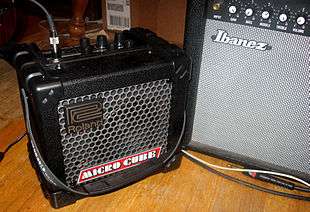Amplifier modeling
Amplifier modeling (also known as amp modeling or amp emulation) is the process of digitally emulating a physical amplifier such as a guitar amplifier. Amp modeling may appear as software, such as plugins for DAWs (Digital Audio Workstation) which may be aided by computer hardware accelerators, or may be part of a standalone device or amplifier. Amp modeling often seeks to recreate the sound of one or more specific models of vacuum tube amplifiers and sometimes also solid state amplifiers.
As part of a digital audio workstation, amp modeling may be applied to a guitar signal that was recorded "clean", in order to achieve the sound of an amplifier being used. This process has the advantage of being dynamic—the amplifier settings can be adjusted without forcing the musician to re-record the piece.

Standalone modeling devices such as the Line 6 POD digitize the input signal and use a DSP, a dedicated microprocessor, to process the signal with digital computation, attempting to achieve the sound of expensive professional amplifiers in a much less costly and more compact device. These modelers can be connected directly to a recording device or PA system without having to use a power section, speaker cabinet and microphone, however, there is an ongoing debate over the question of how accurately a modeler can recreate the sound of a real amplifier.[1] Most modelers generally also include a variety of effects apart from the amp emulations and some can be connected via USB for computer based recording.
Modeling amps such as the Peavey Vypyr, Roland Cube, Fender Mustang, and Line 6's Spider series are amplifiers that include a built-in modeling device. Some high-end modeling amps such as the Vox Valvetronix and the 60/120 watt versions of the Peavey Vypyr[2] combine the digital modeling process with actual vacuum tube amplification.
Analog modeling systems also exist, such as Tech 21's SansAmp line of products.
See also
- Atomic Amplifire - Atomic Amplifire modeler.
- Audiffex ampLion Pro - Precise circuit modeling – simulation of 9 amps, 12 speakers and lots of effects.
- Kemper Profiling Amplifier – profiles your own amps, can share profiles, large user base, plus effects processing.
- Fractal Audio Axe-FX – a rackmount unit which combines amplifier modeling with speaker cabinet simulation and effects processing.
- Roland CUBE – a series of modeling amplifiers.
- Line 6 POD – a series of standalone modeling computers, some designed for digital recording and others for live performance
- Digitech RP series - Contain modeling computers for digital recording and live performance.
- GarageBand – a DAW that has an amp modeler built-in
- Logic Pro a DAW that has an amp modeler plugin
- AmpliTube – Amplifier Emulation Software
- Guitar Rig – Amplifier Emulation Software
- Vox Amplification – Modeling amplifiers with tubes/valves
- Avid Eleven Rack – A rack mount audio interface with integrated Amplifier Emulation DSP
- Yamaha THR5/THR10 series – Yamaha amplifier built with Virtual Circuitry Technology to deliver authentic tube amp sound
- Yonac Tonestack - Ios app with virtual circuit technology to mirror their analogue counterparts topology
References
- ↑ http://daftparagon.com/respectful-disagreement-modeling-amps/
- ↑ "Archived copy". Archived from the original on 2016-02-02. Retrieved 2016-02-02.